The Petersen museum, located on Miracle Mile in central Los Angeles, is always a can’t-miss destination for any gearhead. Recently overhauled, it features a wild exterior design, and an interior filled with some of the rarest wheeled machines ever made. The main exhibit this year is called The Porsche Effect, and it features the cream of Stuttgart’s history, from early aerodynamic efforts to modern hybridized speed. Come take a closer look.

Brendan McAleer/The Globe and Mail
This original 1956 550 Speedster is a twin to the car that James Dean died in, some sixty-odd years ago. Seeing it gives the viewer chills, but there’s nothing menacing about the car itself. This is Porsche at its most pure, light and airy.
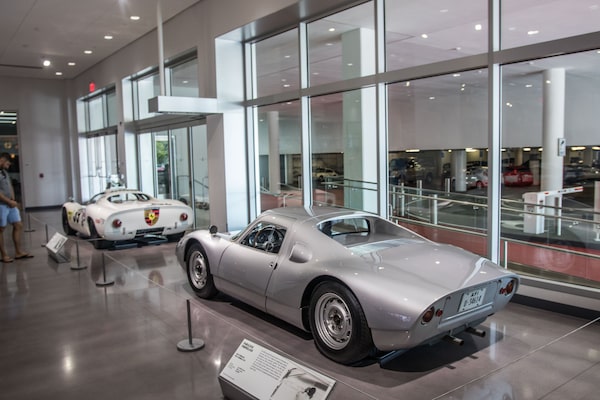
Brendan McAleer/The Globe and Mail
Like the 550, the 904 GTS was a racing special built on the premise that subtracting weight was more important than adding horsepower. The road-racing version is to the left, the street variant is in the foreground.

Brendan McAleer/The Globe and Mail
This model 959 sits at the centre of a display featuring various Porsche designs. As a supercar in the 1980s, the 959 was Porsche’s best guess at what the future might look like – and they were right. All-wheel-drive, twin-turbocharging, and an adjustable suspension are all now commonly found in really quick street cars.

Brendan McAleer/The Globe and Mail
If James Dean is linked with the 550, then the Carrera GT has its own tragic celebrity status. Paul Walker died in the passenger seat of one of these cars, likely as a result of outdated tires. Still, it’s a car to be respected more than feared, and a favourite of veteran Porsche test driver Walter Rohrl.
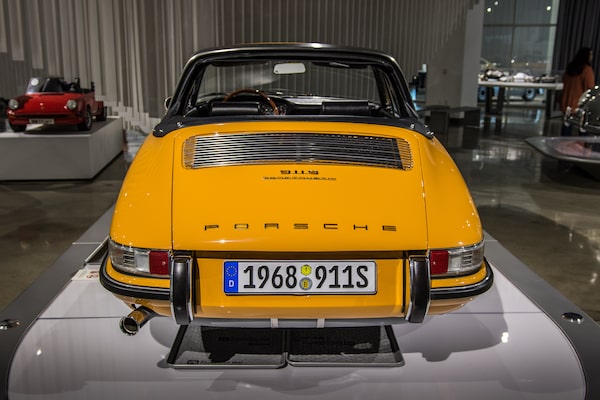
Brendan McAleer/The Globe and Mail
If the 959 was Porsche guessing correctly, the 911 Targa is what happened when they got it wrong. Expecting the United States to outlaw conventional convertibles, Porsche came up with a 911 variant that featured a prominent roll bar. The law never came, but the Targa still found favour with buyers, to the point that there’s still a modern version.

Brendan McAleer/The Globe and Mail
Intended as a replacement for the 911, the front-engined 928 was a fast, V-8-powered grand tourer. Happily, Porsche decided to keep the 911 around, though the 928 has a growing following. This extended-wheelbase, three-doored 928 provides a glimpse into Porsche’s musings on more spacious family-oriented cars. Call it a proto-Panamera.

Brendan McAleer/The Globe and Mail
Don’t wash me! The dirt on this Dakar-racing 959 isn’t from neglect, it’s the original dust picked up on a sprint across the deserts of Africa. Porsche maintains the car in exactly the same condition as when it won the race.
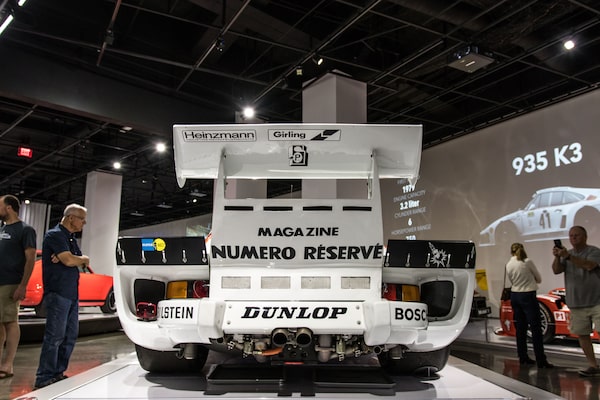
Brendan McAleer/The Globe and Mail
The Porsche 935 is colloquially referred to as the Moby Dick – and it’s pretty easy to see why. Hugely turbocharged, the 935 was successful in endurance racing, both in factory and privateer hands. Racing-obsessed Canadian millionaire Walter Wolf had a street version specially made in 1980, one of the most extreme road-legal machines at the time.

Brendan McAleer/The Globe and Mail
Classic Porsche advertising is simple and effective – as with the vintage cars themselves. Here, there’s an appeal to the sportsman – skiing and golf – and a link made with Steve McQueen. Thanks to the 1971 movie Le Mans, McQueen and Porsche will be forever linked.

Brendan McAleer/The Globe and Mail
Speaking of Le Mans, here’s the second-place car from the 2015 running of the race. A twin to the winning car, this 919 hybrid represents the cutting edge of Porsche speed and perhaps a type of racing machine we’ll never see again. Top-level endurance racing requires an investment of millions, and many competitors, Porsche included, are pulling back to work on electrification.

Brendan McAleer/The Globe and Mail
In the modern era, Porsche’s greatest challenge is to stay true to its heritage while incorporating new technology. Thus, the new cars are still rear-engined, but come with traction control systems to rein in polar momentum and all-wheel-drive capable of getting the power down. Whatever’s going on under the skin, a ducktail spoiler and some Fuchs-look wheels still look great on a 911.
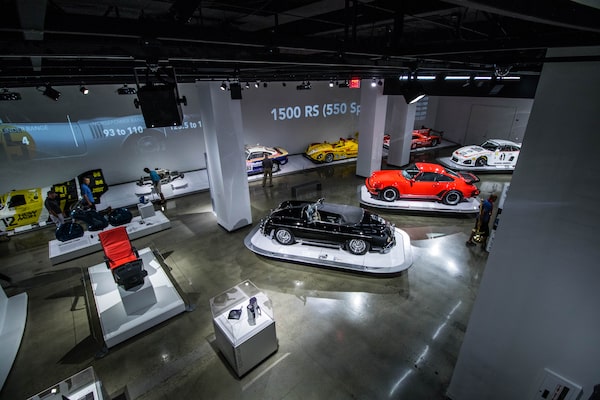
Brendan McAleer/The Globe and Mail
Gathering together everything from coffee mugs to classic Speedsters to proven racing machines, the Petersen’s display shows off the highlights of all facets of Porsche design. There’s something for everyone here.

Brendan McAleer/The Globe and Mail
With pure 1970s excess, the “Turbo” script on the haunches of this 1976 930 swells out over the wide wheelarches. Turbocharging changed the game for Porsche, allowing it to cram ever more power into their flat-six engines without having to sacrifice light curb weights or packaging.
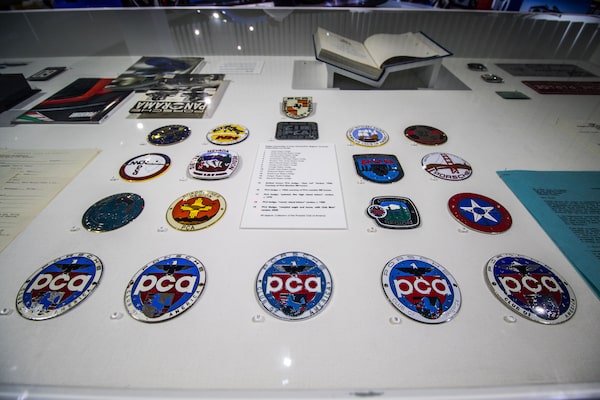
Brendan McAleer/The Globe and Mail
The first Porsche Club of America chapter was founded in Washington in 1955. Thirteen members showed up at the original meeting, but only 12were admitted – the 13th, a Volkswagen owner, was politely asked to leave. Since that time, club chapters have spread all across North America and are often involved not just in shows and cruises, but in charity work and fundraising.

Brendan McAleer/The Globe and Mail
This unusual piece of pottery was created by Steve Smith, a Mohawk artist based in Hagersville, Ont. Used as a trophy for PCA events, it features both the heraldic crest of Stuttgart and symbols of Iroquois culture.

Brendan McAleer/The Globe and Mail
A race-prepped Speedster seems to lead a victory lap for a host of racing Porsches, with the hybrid 919 at the very rear. Over the years, Porsche racers have evolved from lightweight giant-killers to technological powerhouses.

Brendan McAleer/The Globe and Mail
Handwritten timing notes from Porsche’s test track 40 years ago show the painstaking work that went into making their best machines. This is German engineering at its best, a time of white coats and slide-rules.

Brendan McAleer/The Globe and Mail
Can-Am racing was the last frontier for turbocharged racing Porsches, before sanity took hold and safety regulations stepped in. This 1973 917/30 made as much as 1,500 horsepower in qualifying trim and won six out of eight races in the 1973 season. It looks absolutely terrifying.

Brendan McAleer/The Globe and Mail
Built to race in the top-level GT series, the 1996 911 GT1 had little to do with the 911 roadcar. Some suspension parts were shared, but the racing machine was mid-engined, with a water-cooled engine that made some 600 hp. Porsche got around the racing rulebook by making twenty-five road-legal versions; both a competition-spec car and a road car are on display in the Petersen’s lobby.

Brendan McAleer/The Globe and Mail
If you can’t afford a full-sized Porsche, the Petersen’s gift shop has some more reasonable options. The more highly-detailed models are still expensive, but browse around a bit and there are even Hot Wheels for the kids.

Brendan McAleer/The Globe and Mail
Apparently there are no limits to Porsche enthusiasm. A vinyl record of Porsche engine sounds? If somebody will buy it, somebody will make it.

Brendan McAleer/The Globe and Mail
Even the parking lot of the Petersen is a Porsche-spotter’s paradise. This trio of air-cooled classics obviously convoyed over for a tour of the static display, then motored off for their own little slice of Porsche heaven.
The writer was a guest of the automaker. Content was not subject to approval.
Shopping for a new car? Check out the new Globe Drive Build and Price Tool to see the latest discounts, rebates and rates on new cars, trucks and SUVs. Click here to get your price.
Sign up for the weekly Drive newsletter, delivered to your inbox for free. Follow us on Instagram, @globedrive.